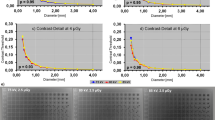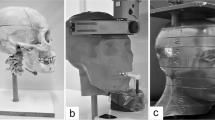Abstract
Background
New developments in processing of digital radiographs (DR), including multi-frequency processing (MFP), allow optimization of image quality and radiation dose. This is particularly promising in children as they are believed to be more sensitive to ionizing radiation than adults.
Objective
To examine whether the use of MFP software reduces the radiation dose without compromising quality at DR of the femur in 5-year-old-equivalent anthropomorphic and technical phantoms.
Materials and methods
A total of 110 images of an anthropomorphic phantom were imaged on a DR system (Canon DR with CXDI-50 C detector and MLT[S] software) and analyzed by three pediatric radiologists using Visual Grading Analysis. In addition, 3,500 images taken of a technical contrast-detail phantom (CDRAD 2.0) provide an objective image-quality assessment.
Results
Optimal image-quality was maintained at a dose reduction of 61% with MLT(S) optimized images. Even for images of diagnostic quality, MLT(S) provided a dose reduction of 88% as compared to the reference image. Software impact on image quality was found significant for dose (mAs), dynamic range dark region and frequency band.
Conclusion
By optimizing image processing parameters, a significant dose reduction is possible without significant loss of image quality.


Similar content being viewed by others
References
ICRP (2004) Managing patient dose in digital radiology. ICRP Publication 93. Ann. ICRP 34:1–73
Reiner BI, Siegel EL, Siddiqui K et al (2006) Quality assurance: the missing link. Radiology 238:13–16
Seeram E (2011) Digital radiography, an introduction. Delmar Cengage Learning, New York
Gonzales RC, Woods RE (2008) Digital image processing. Prentice Hall (3), New Jersey
Canon Inc. (2008) CXDI Image Processing Software MLT(S) User’s Manual. Japan
Beutel J, Sonka M, Fitzpatrick JM (2004) Handbook of medical imaging, vol. 2; Medical image processing and analysis. SPIE, Washington
Bushberg JT, Seibert JA, Leidholdt EM et al (2002) The essential physics of medical imaging. Lippincott Williams & Wilkins (2), Philadelphia
Hart D, Wall BF, Shrimpton PC et al (2000) Reference doses and patient size in pediatric radiology. http://www.hpa.org.uk/web/HPAweb&HPAwebStandard/HPAweb_C/1195733786824
Huda W (2004) Assessment of the problem: pediatric doses in screen-film and digital radiography. Pediatr Radiol 34(3):S173–S182
European Commission (1996) European guidelines on quality criteria for diagnostic radiographic images in pediatrics. Luxemborg
Danish Society of Radiology (2006) Vejledning vedrørende Radiologiske Procedure
Rapp-Bernhardt U, Bernhardt T, Lenzen H et al (2005) Experimental evaluation of a portable indirect flat-panel detector for the pediatric chest: comparison with storage phosphor radiography at different exposures by using a chest phantom. Radiology 237:485–491
Ludwig K, Ahlers K, Wormanns D et al (2005) Lumbar spine radiography: digital flat-panel detector versus screen-film and storage-phosphor systems in monkeys as a pediatric model. Radiology 229:140–154
Hansson H, Båth M, Håkansson M et al (2005) An optimization strategy in a digital environment applied to neonatal chest imaging. Radiat Protect Dosim 114:278–285
Uffmann M, Schaefer-Prokop C, Neitzel U et al (2005) Skeletal applications for flat-panel versus storage-phosphor radiography: effect of exposure on detection of low-contrast details. Radiology 231:506–514
Artinis (2006) Manual—contrast-detail phantom. Artinis CDRAD type 2.0, Zetten
International Commission on Radiation units and Measurements (1989) Tissue substitutes in radiation dosimetry and measurement. ICRU Report 44, Maryland
National Board of Health (2006) Pediatric radiation doses at Radiology. Published at webpage: http://www.sst.dk/publ/Publ2006/SIS/Boernedoser/Boernedoser_radiologi.pdf assessed the 17 October 2011
Tingberg A, Sjöström D (2005) Optimisation of image plate radiography with respect to tube voltage. Radiat Protect Dosim 114:1–3
Almén A, Tingberg A, Mattsson S et al (2000) The influence of different technique factors on image quality of lumbar spine radiographs as evaluated by established CEC image criteria. Br J Radiol 73:1192–1199
Sund P, Båth M, Kheddache S et al (2004) Comparison of visual grading analysis and determination of detective quantum efficiency for evaluating system performance in digital chest radiography. Eur Radiol 14(1):143–150
Månsson LG (2000) Methods for the evaluation of image quality: a review. Radiat Protect Dosim 90:89–99
Bontrager KL (2002) Textbook of radiographic positioning and related anatomi. Bontrager Publishing (4), Arizona
Lanhede B, Båth M, Kherddache S et al (2002) The influence of different technique factors on image quality of chest radiographs as evaluated by modified CEC image quality criteria. Br J Radiol 75:38–49
Brennan PC, Johnston D (2002) Irish X-ray departments demonstrate varying levels of adherence to European guidelines on good radiographic technique. Br J Radiol 75:243–248
Rainford LA, Al-Qattan E, McFadden S et al (2006) CEC analysis of radiological images produced in Europe and Asia. Radiography 13:202–209
Larsen ALS (2006) Videnskab og forskning: en lærebog for professionsuddannelser. Gads Forlag (2):145
Polit DF, Beck CT (2008) Nursing research generating and assessing evidence for nurcing practice. Lippincott Williams & Wilkins (8), Philadelphia
Norrman E (2007) Optimisation of radiographic imaging by means of factorial experiments. Doctoral Dissertation, University of Örebro, Sweden
Fleiss JL (1971) Measuring nominal scale agreement among many raters. Psychol Bull 76:378–382
Efron B (1979) Bootstrap methods: another look at the jackknife. Ann Stat 7:1–26
Miller DP (2004) Obtain robust confidence intervals for any statistic. SAS Institute Inc. Proceedings of the Twenty-Ninth Annual SAS (R) User Group International Conference. SAS Institute Inc, North Carolina
Canon Inc. (2008) Multiobjective frequency processing function manual—MLT(S) edition. Japan
Beutel J, Kundel HL, Van Metter RL (2000) Handbook of medical imaging, vol. 1; Physics and Psychophysics. SPIE, Washington
Crevret S (2006) Statistical methods for dose-finding experiments. Wiley, England
Eubank RL (1999) Nonparametric regression and spline smoothing. CRC press, New York
Härdle WK, Müller M, Sperlich S et al (2004) Nonparametric and semiparametric models. Springer, Berlin
Author information
Authors and Affiliations
Corresponding author
Rights and permissions
About this article
Cite this article
Precht, H., Gerke, O., Rosendahl, K. et al. Digital radiography: optimization of image quality and dose using multi-frequency software. Pediatr Radiol 42, 1112–1118 (2012). https://doi.org/10.1007/s00247-012-2385-3
Received:
Revised:
Accepted:
Published:
Issue Date:
DOI: https://doi.org/10.1007/s00247-012-2385-3




